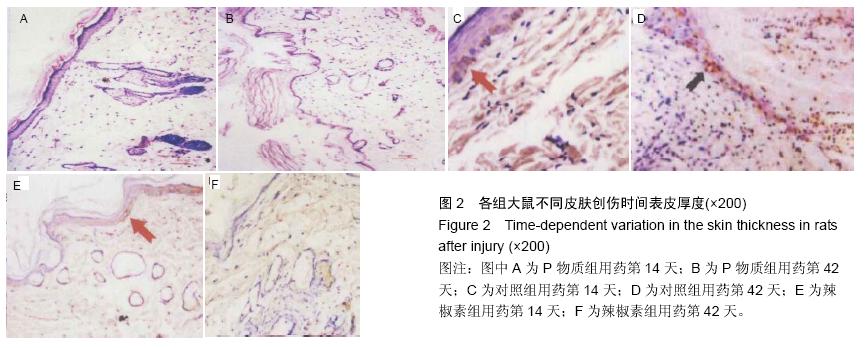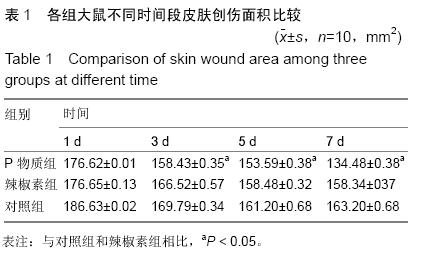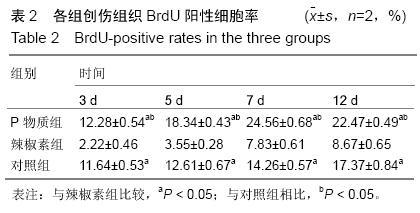| [1] 朱王刚,蔡青,刘世清,等.早期大剂量应用丹参对急性颈髓损伤患者血液流变性的影响[J].微循环学杂志,2009, 19(4): 61-62.[2] 王茂林,陈世益,李云霞,等.黄芪丹参注射液对大鼠急性骨骼肌钝挫伤后微循环的影响[J].中国运动医学杂志,2009, 28(6):651-653.[3] 宋少华,郭闻渊,傅志仁,等.丹参多酚酸盐负性调节小鼠骨髓来源树突状细胞成熟及其部分免疫功能[J].第二军医大学学报,2009,30(12):1333-1337.[4] 张雷,郑芙林,李珊珊,等.隐丹参酮对淋巴细胞增殖反应的影响[J].时珍国医国药,2010,21(1):92-93.[5] 曾煦欣,王春霞,王芳,等.丹参对大鼠粘连成纤维细胞增殖与胶原合成的作用研究 [J].中华中医药杂志,2011,26(8): 1839-1841.[6] Spaas JH, Gomiero C, Broeckx SY, et al. Wound- healing markers after autologous and allogeneic epithelial-like stem cell treatment. Cytotherapy. 2016; 18(4):562-569.[7] Zhou T, Yang Z, Chen Y, et al. Estrogen Accelerates Cutaneous Wound Healing by Promoting Proliferation of Epidermal Keratinocytes via Erk/Akt Signaling Pathway. Cell Physiol Biochem. 2016;38(3):959-968.[8] Saldanha SN, Royston KJ, Udayakumar N, et al. Epigenetic Regulation of Epidermal Stem Cell Biomarkers and Their Role in Wound Healing. Int J Mol Sci. 2015;17(1). pii: E16.[9] ardien KL, Marck RE, Bloemen MC, et al. Outcome of Burns Treated With Autologous Cultured Proliferating Epidermal Cells: A Prospective Randomized Multicenter Intrapatient Comparative Trial. Cell Transplant. 2016;25(3):437-448.[10] Vagnozzi AN, Reiter JF, Wong SY. Hair follicle and interfollicular epidermal stem cells make varying contributions to wound regeneration. Cell Cycle. 2015;14(21):3408-3417.[11] Guo R, Chai L, Chen L, et al. Stromal cell-derived factor 1 (SDF-1) accelerated skin wound healing by promoting the migration and proliferation of epidermal stem cells. In Vitro Cell Dev Biol Anim. 2015;51(6): 578-585.[12] Bourke CD, Prendergast CT, Sanin DE, et al. Epidermal keratinocytes initiate wound healing and pro-inflammatory immune responses following percutaneous schistosome infection. Int J Parasitol. 2015;45(4):215-224.[13] Wikramanayake TC, Stojadinovic O, Tomic-Canic M. Epidermal Differentiation in Barrier Maintenance and Wound Healing. Adv Wound Care (New Rochelle). 2014;3(3):272-280.[14] Xiong B, Cheng Y, Ma L, et al. MiR-21 regulates biological behavior through the PTEN/PI-3 K/Akt signaling pathway in human colorectal cancer cells.Int J Oncol. 2013;42(1):219-228.[15] Ribas J, Ni X, Castanares M, et al. A novel source for miR-21 expression through the alternative polyadenylation of VMP1 gene transcripts.Nucleic Acids Res. 2012;40(14):6821-6833.[16] Li J, Huang H, Sun L,et al. MiR-21 indicates poor prognosis in tongue squamous cell carcinomas as an apoptosis inhibitor.Clin Cancer Res. 2009;15(12): 3998-4008.[17] Wang T, Feng Y, Sun H, et al. miR-21 regulates skin wound healing by targeting multiple aspects of the healing process.Am J Pathol. 2012;181(6):1911-1920.[18] Madhyastha R, Madhyastha H, Nakajima Y, et al. MicroRNA signature in diabetic wound healing: promotive role of miR-21 in fibroblast migration. Int Wound J. 2012;9(4):355-361.[19] Zhang Z, Zha Y, Hu W, et al. The autoregulatory feedback loop of microRNA-21/programmed cell death protein 4/activation protein-1 (MiR-21/PDCD4/AP-1) as a driving force for hepatic fibrosis development. J Biol Chem. 2013;288(52):37082-37093.[20] Philandrianos C, Andrac-Meyer L, Mordon S, et al. Comparison of five dermal substitutes in full-thickness skin wound healing in a porcine model. Burns. 2012; 38(6):820-829.[21] 曾煦欣,王芳,蒋泓,等.丹参抑制人粘连成纤维细胞增殖的作用研究[J].中国药房,2011,22(27):2514-2516.[22] 王得胜,刘莉.丹参对胆道损伤修复过程中转化生长因子 β1表达的影响及其意义[J].广东医学,2011,32(12): 1535-1537.[23] 蒙晓,王成蹊,蔡洪福,等.丹参酮ⅡA 对腹部术后粘连大鼠成纤维细胞增殖及其相关基因表达的影响[J].中草药, 2012,43(7):1381-1384.[24] 支文煜.脑缺血再灌注损伤引起的线粒体功能障碍及丹参酮ⅡA的保护作用研究[J].实用心脑肺血管病杂志, 2010, 18(10):1389-1391.[25] 黄震亚,陈天鹏,梁宇,等.丹参对重度烧伤器官缺血再灌注损伤保护作用的临床观察[J].现代预防医学,2011,38(5): 968-970.[26] 李玉娟,韩冬,徐想顺,等.丹参素对脂多糖引起的小鼠脑微循环障碍的改善作用[J]. 微循环学杂志,2010,20(2): 62-63.[27] 蔡青,张伯礼,黄淑芸,等. 丹参酮 B 钠盐对局灶性脑缺血/再灌注损伤大鼠海马神经递质含量的影响[J].天津中医药,2010,27(6):486-489.[28] Yin X, Yin Y, Cao FL, et al. Tanshinone IIA attenuates the inflammatory response and apoptosis after traumatic injury of the spinal cord in adult rats. PLoS One. 2012;7(6):e38381.[29] 辛霞,金鲜珍,阮瑞霞,等.负压吸引技术在外科延迟愈合伤口护理中的应用[J].护理研究,2014,28(3): 837.[30] Jiang L, Liu T, Song K. Growth characteristics of human adipose-derived stem cells during long time culture regulated by cyclin a and cyclin D1. Appl Biochem Biotechnol. 2012;168(8):2230-2244.[31] 杨世茂,王明国,李静,等.复合 ADSCs/β-TCP组织工程骨与PRF修复下颌骨缺损的实验研究[J]. 实用口腔医学杂志,2012,28(6): 686-690.[32] Herreros MD, Garcia-Arranz M, Guadalajara H, et al. Autologous expanded adipose-derived stem cells for the treatment of complex cryptoglandular perianal fistulas: a phase III randomized clinical trial (FATT 1: fistula Advanced Therapy Trial 1) and long-term evaluation. Dis Colon Rectum. 2012;55(7):762-772.[33] 杨超,邢新,徐达圆,等.脂肪干细胞-透明质酸复合物促进放射性复合损伤创面愈合的初步研究[J].中国修复重建外科杂志,2011,25(12): 1499-1503.[34] Kajiyama H, Hamazaki TS, Tokuhara M, et al. Pdx1-transfected adipose tissue-derived stem cells differentiate into insulin-producing cells in vivo and reduce hyperglycemia in diabetic mice. Int J Dev Biol. 2010;54(4):699-705. [35] Zhang X, Liu L, Wei X, et al. Impaired angiogenesis and mobilization of circulating angiogenic cells in HIF-1alpha heterozygous-null mice after burn wounding. Wound Repair Regen. 2010;18(2):193-201.[36] Mansilla E, Spretz R, Larsen G, et al. Outstanding survival and regeneration process by the use of intelligent acellular dermal matrices and mesenchymal stem cells in a burn pig model. Transplant Proc. 2010; 42(10):4275-4278.[37] 张华.敛痔散在肛肠病术后伤口换药中的疗效观察[J].中医外治杂志,2009,18(4):28-29.[38] 孔焕宇,孔繁飞,黄清怡,等.大鼠创面愈合过程中表皮干细胞增殖分化与玉红膏的影响[J].中国组织工程研究与临床康复,2007,46(11):9400-9403.[39] 吕国忠,周红梅,赵朋,等.体外培养表皮干细胞复合高分子支架原位修复深度烧伤创面的研究[J].中华损伤与修复杂志:电子版,2011,6(1):14-19[40] 钟清玲,刘德伍,刘繁荣,等.羊膜负载表皮干细胞促进糖尿病大鼠创面的愈合[J].中国组织工程研究与临床康复, 2010,14(32):6010-6014.[41] 李澄,吕红莉,李燕,等.皮肤干细胞体外培养与诱导分化[J].中国现代医学杂志,2010,20(19):2950-2952.[42] 王秀卿,王志玲,刘会敏.人表皮干细胞的培养技术[J].白求恩军医学院学报,2009,7(5):342-343.[43] 廖立新,陈刚泉,李国辉,等.应用表皮干细胞构建组织工程皮肤及移植实验[J].中国组织工程研究与临床康复,2007, 11(14):2661-2664.[44] 张彦刚,胡大海,张战凤,等.人表皮干细胞改良培养及其组织工程皮肤的构建[J].中国美容医学,2011,20(1):79-82.[45] 高志雄,王威,吕恩基,等.针刺上巨虚穴缓解慢性内脏痛敏的作用及机理[J].山西大同大学学报:自然科学版,2010, 26(3):42-44.[46] 吴玉芳,刘浩,郝建军,等. 针刺镇痛对结肠镜检查患者疼痛程度及体内β-内啡肽、P物质水平的影响[J].中西医结合研究,2012,4(2):57-60.[47] 王振宇,李淑莲,王希文,等.脊髓背角P物质在电针调控炎性痛大鼠神经-免疫网络中的作用研究[J].中医药学报, 2012,40(3):88-90.[48] 孙卫兵,杨帆,齐清会.电针次髎穴对慢性膀胱过度活动症模型大鼠尿动力学及脊髓背角SP和CGRP影响[J].大连医科大学学报,2012,34(3):220-224. |
.jpg)



.jpg)
.jpg)